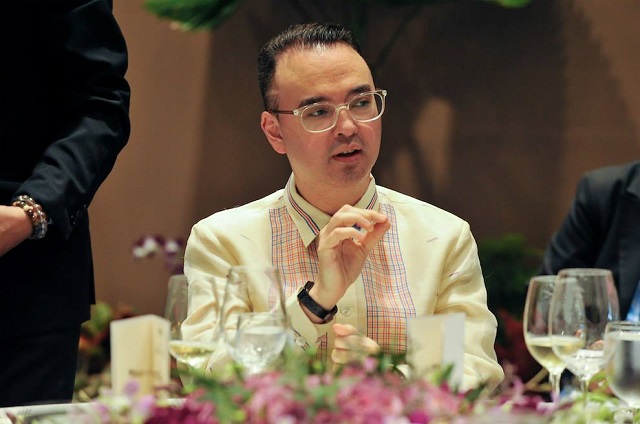Proposed Joint PH-China Oil and Gas Exploration: Where’s the Framework?

Secretary Alan Peter Cayetano | Photo from the Department of Foreign Affairs’ (DFA) Facebook account.
BEFORE LEAVING for the ASEAN Ministerial Meeting in Singapore, Foreign Affairs Secretary Alan Peter Cayetano said in a July 31 press briefing that the Philippine government offered to China a “starting proposition” of a 60-40 profit-sharing scheme in the joint oil and gas exploration of the West Philippine Sea, patterned after the Malampaya gas-to-power project. He said the framework agreement being drafted by the Philippines is still in the works, and that the Philippine government hopes to “exchange drafts” with China by September at the latest.
Following his bilateral meeting with Chinese President Xi Jinping on the sidelines of the Boao Forum for Asia last April, Cayetano announced that President Rodrigo Duterte gave the green light to the drafting of the framework agreement on the joint activity. Xi did the same, Cayetano said then.
The Philippine government has presented the undertaking as the solution to the threat to the country’s energy security. The Malampaya gas field, which supplies power to the Luzon island grid, is projected to run out of reserves in less than a decade. But because no draft agreement or related document with China has been made public since Duterte’s “green light,” the proposed joint exploration scheme raises more questions than answers.
Following Cayetano’s lead, reports focused on the “word war” between him and former president Benigno Aquino III regarding the different policy paths pursued by the current and previous administrations.
CMFR monitored reports from nine broadsheets (Philippine Daily Inquirer, The Philippine Star, Manila Bulletin, The Manila Times, Daily Tribune, Manila Standard, BusinessWorld, BusinessMirror and Malaya) and four primetime news programs (ABS-CBN 2’s TV Patrol, GMA-7’s 24 Oras, TV5’s Aksyon, and CNN Philippines’ News Night) on free TV from July 31 to August 8.
In making this a partisan issue, the media missed the substantial story which is the framework agreement and how this addresses the concerns about joint exploration.
In a press briefing on August 7, Cayetano told the media that Duterte had approved “in principle” the creation of a technical working group (TWG) on the framework agreement composed of the Departments of Environment and Natural Resources, Energy, National Defense, Interior and Local Government, and Justice; the National Security Council; the Office of the Solicitor General; and a group of legal experts for advisory and negotiating purposes. As he had previously claimed, Cayetano said the agreement will abide by what the Constitution says. He had nothing else to add about the framework that will govern the Philippine-China exploration.
Again, Cayetano was the sole source of the reports on this briefing, which failed even to identify who specifically are involved in the TWG.
There was no attempt to examine the scheme’s similarity to or difference from the Joint Marine Seismic Undertaking (JMSU) that China signed on with Vietnam, during the Arroyo administration; although there were questions as well about the legality of the JMSU. (See, “Context Missing: Reporting the PH-China Joint Exploration Proposal“).
With matters of security and sovereignty at stake, the media should not allow only a few to steer the conversation. But this is exactly how the media have failed to inform the public about the PH-China cooperation over resources in the West Philippine Sea. Thus, the announcement of the readiness to establish a framework should have provoked more questions about who are involved and what paramount concerns they will take up.
Supreme Court Associate Justice Antonio Carpio, for example, said he does not object to the joint development as long as it complies with the Constitution and the Philippines’ sovereign rights are asserted in the framework agreement (Star, Inquirer, ABS-CBN). Security analyst Rommel Banlaoi echoed Carpio’s statement in a 24 Oras report.
BusinessMirror alone referred to the JMSU issue. In an interview with that newspaper, Prof. Jay Batongbacal of the UP Institute of Maritime Affairs and Law of the Sea said that the Supreme Court should rule first on the constitutionality of the JMSU and similar schemes. Only then “can a decision on the modality of the supposed joint exploration and development deal with China be reached,” Batongbacal told BusinessMirror.
The maritime expert also warned that pursuing Charter Change alongside joint exploration may pose legal uncertainties that would complicate the negotiations with China.
BusinessMirror also cited Sen. Joel Villanueva, who said he was “pressing” for a Senate review of the proposed exploration to make sure any agreement with China “will not be used to compromise our economic and political sovereignty.”
In issues as sensitive as joint undertakings with China, whose maritime aggression has already cost the Philippines its marine resources, context and pluralistic views are all the more needed in reports. The media should not merely repeat DFA claims made during the occasional press briefing.
By now, the framework should have been discussed in reports as an inter-departmental effort, and journalists should be pursuing the different officials who are going to work on the terms of agreement, in order to keep up with the process and to check actions that may contradict the country’s best interests.
Leave a Reply